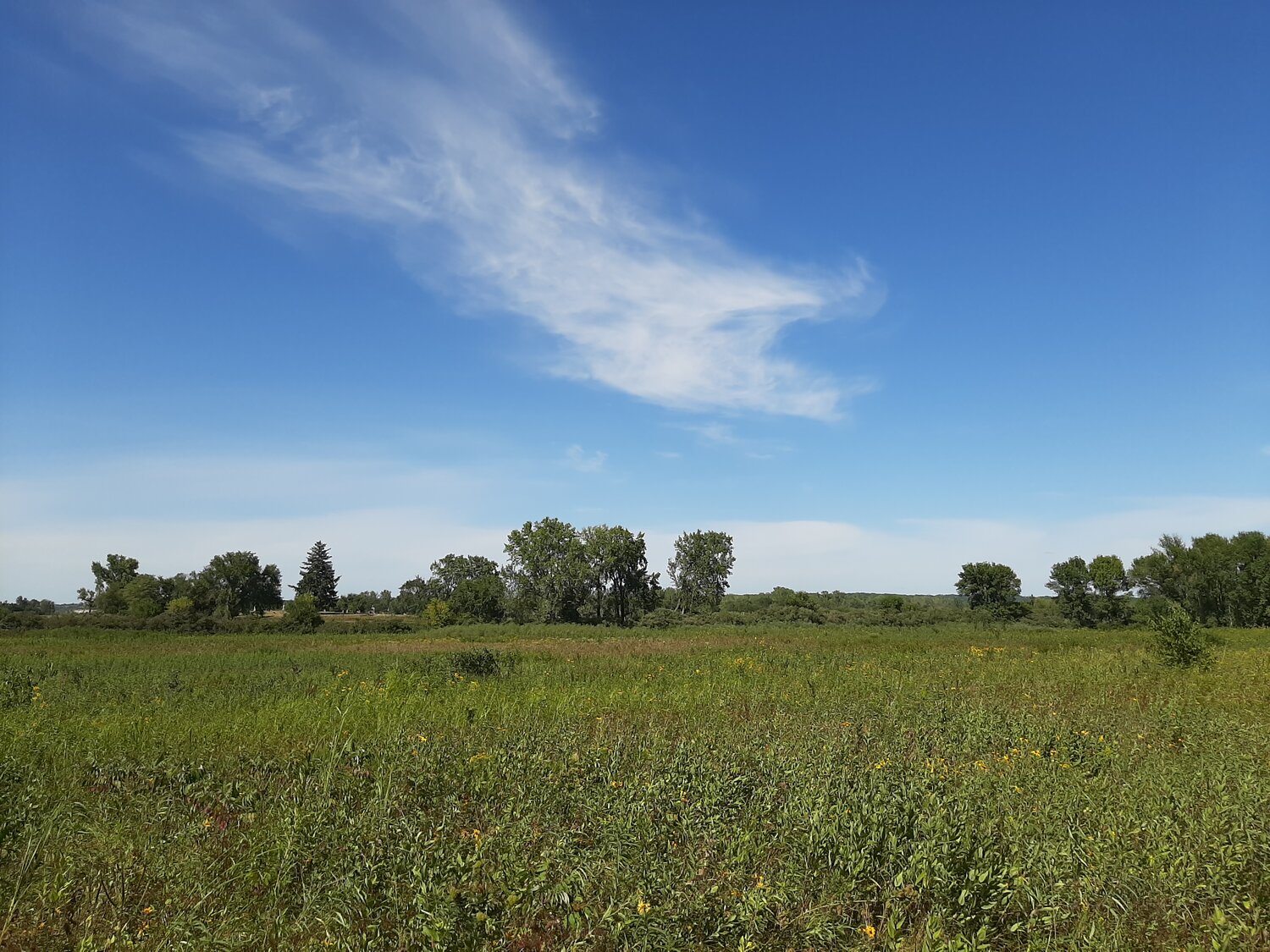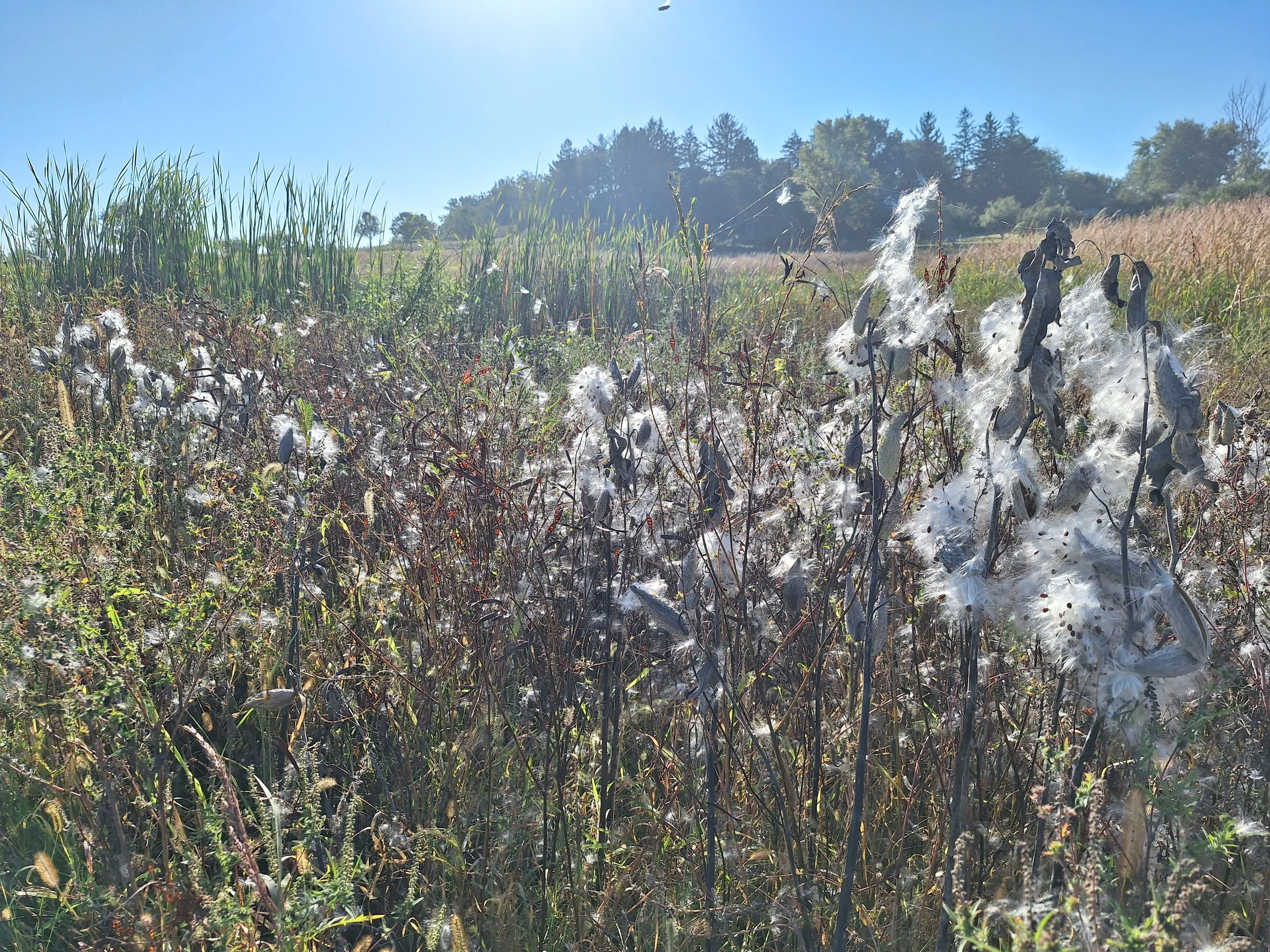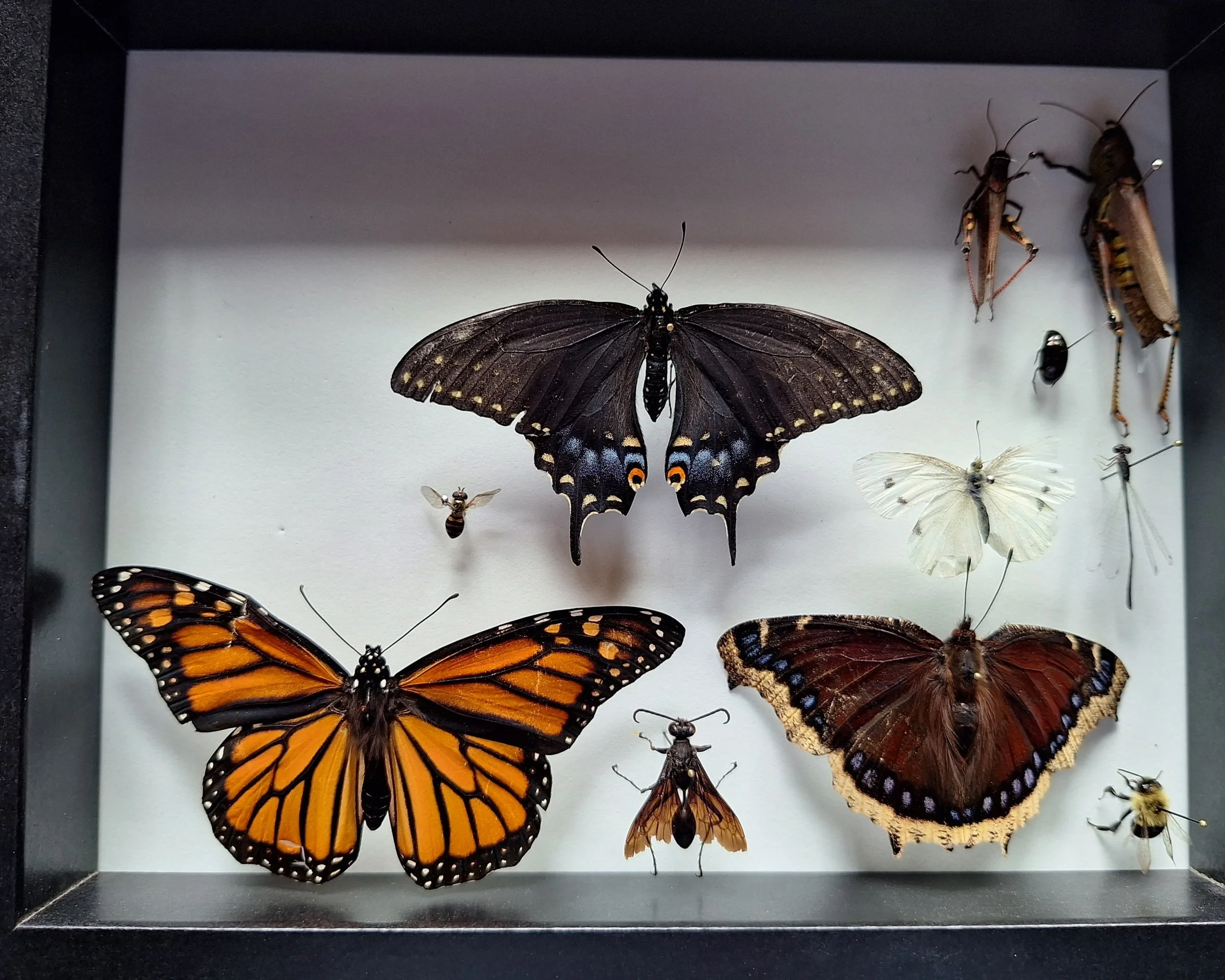Still Teaching & Learning
“If all mankind were to disappear, the world would regenerate back to the rich state of equilibrium that existed ten thousand years ago. If insects were to vanish, the environment would collapse into chaos.” –E. O. Wilson
Milkweed floss & seeds waiting for a breeze.
The last couple of Septembers, I’ve slipped back into teaching. When this opportunity was originally proposed to me, it wasn’t a hard decision – hanging out with kids was always my favorite part of the job I retired from in 2020. So, I’m again teaching Farm Term at Scattergood Friends School, a four-week term designed to instill a sense of community among students and remind them of the importance of the farm, a fifteen-minute walk from campus through prairie, pasture, and farmland.
Located three miles east of West Branch, Scattergood was established in 1890 by Iowa Quakers. It shut down in 1931 during the Depression, but in 1939, Quakers converted Scattergood into a hostel for refugees from Nazi Germany. During the war, 185 refugees were sheltered at Scattergood until they could be resettled elsewhere in the United States.[1] The school reopened after the war and now serves about forty middle and high school students, the majority of whom are boarders.
I’m co-teaching with Ben, Scattergood Farm’s assistant manager and one of the school’s science teachers, a course we’ve named Insects in Culture and Agriculture. Eleven high school students have signed up for the course, one-third the number often on my rosters at Cedar Rapids Washington High School.[2]
Prairie with Scattergood Farm in the background
In August, I dove into the task of selecting and organizing readings for the course. I scoured collections of Japanese haiku, Emily Dickinson’s poetry, Ross Gay’s Book of Delights, Aimee Nezhukumatathil’s World of Wonders, Henry David Thoreau’s Walden. The haiku’s diminutive form seems particularly suited to the subject of insects:
For you fleas too The cicada shell –
the nights must be long, it sang itself
they must be lonely. utterly away.
–Issa (1763-1828) –Bashō (1644-1694)
I found insect poems by John Keats and Mary Szybist, Robert Hass and D. H. Lawrence, Yusef Komunyakaa and Harryette Mullen. I not only rediscovered Eric Carle’s The Very Hungry Caterpillar but discovered his The Very Quiet Cricket and The Very Lonely Firefly. My friend Bobbie sent me excerpts from Candice Millard’s River of Doubt: Theodore Roosevelt’s Darkest Journey, which describe the amazing insects Roosevelt and his team encountered as they explored the upper tributaries of the Amazon.
Early Autumn by Qian Xuan, Chinese, 1235-1305
When the web search engine picked up on my new interest, insect-related sites began popping up on my feeds. In wildly different ways, Catherine Chalmers, Jennifer Angus, and Raku Inoue place insects at the heart of their art.[3] Ariella Elovic’s 2023 New Yorker cartoon “Dating Prospects as Insects” is hilariously spot-on. A teacher friend, Molly, is posting beautiful photographs of insects on Facebook almost daily.
🪲 🪲 🪲
At 9:20 on September 4, our class meets at a pair of long folding tables under a shady maple at the farm. With the exception of a mid-morning snack break, we go till noon. You might be wondering, How in the world do you hold the attention of high school kids for over two hours? Keep in mind this is a co-taught interdisciplinary course. On most days, our class begins with thirty minutes of reading and discussing poetry or short prose, Ben takes the two middle forty-minute segments, often with a hands-on element – such as measuring insect diversity by collecting and counting insects by order and applying the Shannon Index formula – and I help the kids wind down with a prompt that steers them toward some creative and reflective writing.
I’m thrilled by this opportunity to expand my knowledge of insects. As I reflect at the end of our first day, I think about how this class will challenge me to slow down and look closely to pay heed to these tiny members of the Kingdom Animalia who, as Ben reminds us, share particular characteristics: three body parts (head, thorax, and abdomen), three pairs of jointed appendages, two antennae, compound eyes, and some form of metamorphosis.
As I sit in the grass and write, the bright yellow caterpillar of a tussock moth crawls up my pant leg, an ant explores the terrain of my T-shirt. I wonder what they’re looking for, where they’re going. Are they lost or looking for friends? I think about the admirable sociability of ants, who work cooperatively as part of well-organized colonies.
I recall insect memories: The time I was straddling a branch of the sweet gum in the front yard of my childhood home and, noticing the slight movement of a nearby twig, realized it was a walking stick, one of the most bizarre-looking insects, a genius at camouflage. The time I accidentally tromped on an underground yellowjacket nest in the lot behind our house, causing them to swarm up around me, stinging me, getting inside my clothing. I raced away like a maniac, frantically yelling for help. My mother came out, stripped me down to my underwear, brushed off any wasps still hanging on by their stingers, and took me indoors, where she made a bowl of baking soda paste to apply to each venomous sting. I didn’t blame the yellowjackets for defending their home, and I did steer clear of that nest from then on.
🪲 🪲 🪲
By the second day of class, the students are beginning to collect insects for the specimen boxes they will be creating – sweeping the fields with nets, looking under rocks and decayed logs, catching insects with jars or their bare hands. It’s a delight to see how excited the kids are as they rush off with their nets and plastic storage bags, returning with insects they identify by name and order, then researching the roles they perform on the farm. Is there any doubt about the power of hands-on learning? Two students return to the table, one of them carefully cupping in his hands an impressive insect species:
Praying mantis flies
into the surprise of
Badrawi and Harry.[4]
🪲 🪲 🪲
Every day at lunch, the cook rattles off the litany of ingredients from the farm, everything from lamb to spaghetti squash to jalapeños and basil. “Yay Farm!” we all respond. We’re constantly immersed in the reality of our coexistence with plants and animals. During break, we eat fresh-picked watermelon and pears, sharing our rinds and cores with the flock of turkeys, who will become the centerpieces of supper tables in two and a half months. Bees have pollinated the apple trees now being harvested for apple cider, applesauce, apple crisp. Dragonflies swoop and dart and swerve, thanks to their two pairs of independently functioning wings, and devour up to a hundred mosquitoes a day, decimating the population of one of the most annoying (and in some parts of the world, dangerous) insect pests. I’m surprised to learn that male mosquitoes are also pollinators, it’s only the female mosquitoes that practice vampirism.
The stroll from campus to farm is one of my favorite parts of the day. There’s always something new to see, and it often gives me a chance to chat with students. While walking with Seth and Rosie this morning, Seth points up in the sky – a kettle of at least twenty broad-winged hawks, wheeling and gliding as they ride the warm updraft of a thermal on their way south.
Monarch caterpillar feasting on milkweed.
This first week, noticing the new purple martin houses, I ask Ben about them.
The Beauty of Purple Martins
At the organic farm, two miniature condominiums were installed atop tall poles over the gardens, near the chicken shed, the turkey roost, the pig sty, the summer greenhouse, the barn. A “Nests To Let” sign was posted to attract purple martins returning to the Midwest after wintering in South America. When the birds learned in the spring of this newly available housing, they checked out the condos and then moved in. Comfortable with roosting in crowds, they didn’t mind the cramped living conditions of the two-story, twelve-unit structures. Their liquidy morning songs could be heard from the work shed, from the silo covered with trumpet flower vines, from the apple orchard, the sheep pasture, the woodlot. They patrolled the farm and snatched flies out of the air at a surprising rate, performing for any audience who admires their sleek body shape, glossy dark-blue crowns and breasts, and skills at acrobatically swooping and diving as they feasted on flies that would have tormented and harmed the much-beloved Ned the donkey and other farm animals. The rent they paid for their seasonal homes was covered through the barter system. In exchange, they kept the fly population manageable and rendered insecticides redundant.
🪲 🪲 🪲
Today, Ben brings out packages of dried insects for snack break. It becomes a dare – who will pop a cricket or grasshopper in their mouth? The cricket’s body is curled in, like a black lozenge, crunchy as popcorn, a mild nutty flavor. The grasshopper has a slightly bitter aftertaste. I could imagine dried crickets and grasshoppers mixed in with the nuts, seeds, rolled oats, and dried fruit of trail mix. I could imagine them dipped in a flour batter and fried – insect tempura.
As we write at the end of class, sweat bees hover near me and then land on my hand and quietly explore. Animated black-and-gold jewelry, they seem friendly, curious, somehow optimistic.
Sweat Bee Sonnet
While I scribble under a maple tree
two sweat bees flit around me, then hover.
I admire their smoky wings and their bright
yellow and black bands. They’ve been visiting
the eggplant and tomato blooms, but now
these angels alight on my arm, working
in silence, antennae nosing around,
bodies flexing, generating no buzz.
Apathetic about stinging, their jam is
the salty electrolytes of my sweat.
They have no desire for undeserved fame,
nor strive to project fear by fanning flames.
They are my friends and I am their flower.
🪲 🪲 🪲
We learn not only about insects but also about the roles they play on the farm – as pollinators, nutrient recyclers, pests, predators of pests, and farmed insects. We’re constructing an edifice of entomological knowledge. Ben often walks around the table as we go through the day’s handout, testing and praising the kids’ grasp of insects as he does. Even though we’re outdoors and distractions are numerous, the kids are focused. Ben embodies a theory I’ve always adhered to. The writer Kaveh Akbar recently expressed it this way: “The best pedagogy is the demonstrable enthusiasm for the material you’re teaching.”
Today, I invite the students to ghostwrite a short memoir for some insect. Having learned that dragonflies can fly up to 30 miles per hour and migrate up to 1,500 miles, I imagine the odyssey of one dragonfly. He sets off on an October morning, shaking off the chilly dew and soaring into the wild blue yonder. Although humans are no threat to him that high in the sky, he has to keep a compound eye peeled for birds. He follows the Mississippi River, swooping under the Gateway Arch, stopping in Memphis, because all dragonflies, of course, dig the blues.
🪲 🪲 🪲
I interject songs as texts for discussion: “The Moth” by Aimee Mann, “Queen Bee” by Taj Mahal, “Honey Bee” by Lucinda Williams, “B Side” by Loudon Wainwright III, and others. I lead a couple of sing-alongs – “The Ants Go Marching” and “I Know an Old Lady Who Swallowed a Fly” – and the kids humor me by joining in with surprising gusto. We decide to curate a class playlist – the kids adding songs by Gorillaz, Crazy Town, Jason Mraz, Cavetown, Metallica, Haley Heynderickx – that we listen to when in the science lab, doing the painstaking work of pinning our insects or carving linoleum blocks to make insect prints.
One of our student’s linocut prints.
🪲 🪲 🪲
We go on a field trip north of Iowa City to Turkey Creek Nature Preserve, one of the sections of land protected by the Bur Oak Land Trust. The kids relish getting into the cold shady creek, turning over rocks, finding toe-biters and damselfly larvae. We wade deeper, up to our knees, catching crawdads and studying them as they try to pinch us with their tiny claws.[5]
Studying insects in the creek feels like touching grass, answering the call Utah Governor Spencer Cox recently made before a national audience after yet another tragic shooting: “I would encourage people to log off. Turn off. Touch grass.” As we play, we learn some things and unlearn others. We inhale the fresh air of our original selves, unqualified and unmonitored.
I think a lot about current events over the course of this month, the need to reject the division of “us and them,” the remainder of which is a hatred that seeps into souls and rots them from the inside. That division is designed for the sole purpose of concentrating power in the hands of a few. But there’s only us, and though we don’t all think or see the world the same way, we’re all human, we laugh and cry, we feel grief and joy, we delight in our planet’s smallest beings.
🪲 🪲 🪲
The Presentation of Learning occurs on the last day of Farm Term. With Scattergood students and staff, parents and grandparents, and a vanload of students from The Good Earth School, there are at least fifty attendees.[6] Ben and I explain the goals of the course. Three students read the poetry and prose they have published in Insectzine, the class zine. Then they move in pairs to their tables, where they present each insect in their specimen box to rotating groups of ten folks, using the field guides they created as a reference. Many people approach Ben and me afterward to tell us how impressed they are by the quality of the students’ presentations.
One of the students’ specimen boxes, work in progress.
I’ve loved the enthusiasm of our class. Who would think we could get so excited about insects? I know my appreciation and respect for insects has grown because of my experiences over these four weeks. I kept returning to this poem as the course proceeded, and it became my contribution to Insectizine.
Ode to Goldenrod
At the tip of a yellow bloom
on a stalk of goldenrod six feet tall in mid-September
a green inchworm measures its worth.
An ant climbs to its stratospheric heights.
Two bees gather pollen and nectar
to make honey from the tiny sun-soaked florets
that run along stems spraying out like a fountain,
the whole plant some golden scepter or ceremonial staff
held aloft by the lords of summer in the last days of their reign.
Nearby cornfields are drying brown,
leaves rustling in the breeze,
golden ears peeking out from the tops of the husks.
Mown hay too is drying to a flaxen brown.
Even the maple leaves are thinking in their hearts of going gold.
My eyes are drawn to all the yellow – dahlias and marigolds,
bright patches of sawtooth sunflowers and black-eyed susans
nodding under the noonday sun.
Cloudless sulphurs and ghost yellows flit over the fields,
always one step ahead of us.
Gangs of goldfinch urge us to Cheer-up, cheer-up, cheer-up
as they feed on the fat seedheads of sunflowers
turned to greet the rising sun.
And the yellow and black bands of sweat bees and hoverflies
that land to kiss our hands – all this precious gold,
all this sweet existence we treasure
and will hold on to as long as we can.
My youngest son sometimes signed off his emails to me,
“Stay gold,” quoting the movie (and hence, the poem),[7]
and I’m trying to, Jesse, and yet
it doesn’t ease my missing you.
Oh you youths lingering on the lips of your lives,
we exhort you to dive deep,
cherish these sweet golden days,
forge ahead never ceasing.
We’ve tried to show you a path toward peace and compassion.
The shafts of gold sway and dance in sunshine
that returns daily, like an ancient promise.
We’ll meet again in a field filled with goldenrod
out beyond the reach of nations.
Scattergood Pollinator Prairie
Footnotes
[1] H. M. Bouwman’s 2025 young adult novel Scattergood uses the school and that era as an essential backdrop.
[2] Back then, it wasn’t unusual to see over 150 students in my classroom on any given day.
[3] For instance, view Chalmers’s “Antworks” video.
[4] All students’ names have been changed.
[5] If you’re from the South, you might call them crawfish, and some folks call them crayfish, but they’re all the same freshwater crustacean.
[6] The Good Earth is a PK-6 school located near Solon that offers nature-based education.
[7] Francis Ford Coppola’s The Outsiders and Robert Frost’s “Nothing Gold Can Stay.”







